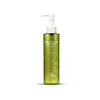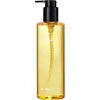What's inside
What's inside
 Key Ingredients
Key Ingredients

 Benefits
Benefits

 Concerns
Concerns

 Ingredients Side-by-side
Ingredients Side-by-side

Canola Oil
EmollientTriethylhexanoin
MaskingPEG-20 Glyceryl Triisostearate
EmollientPEG-8 Isostearate
EmulsifyingHelianthus Annuus Seed Oil
EmollientSqualane
EmollientOlea Europaea Fruit Oil
MaskingRosa Canina Fruit Oil
EmollientCamellia Japonica Seed Oil
EmollientMacadamia Ternifolia Seed Oil
EmollientSodium Hyaluronate
HumectantEuterpe Oleracea Fruit Extract
Propolis Extract
Skin ConditioningTocopheryl Acetate
AntioxidantCamellia Sinensis Leaf Extract
AntimicrobialPyrus Communis Fruit Extract
Skin ConditioningRosa Damascena Flower Water
MaskingIris Florentina Root Extract
MaskingCucumis Melo Fruit Extract
Skin ConditioningHedera Helix Leaf/Stem Extract
AntimicrobialCanola Oil, Triethylhexanoin, PEG-20 Glyceryl Triisostearate, PEG-8 Isostearate, Helianthus Annuus Seed Oil, Squalane, Olea Europaea Fruit Oil, Rosa Canina Fruit Oil, Camellia Japonica Seed Oil, Macadamia Ternifolia Seed Oil, Sodium Hyaluronate, Euterpe Oleracea Fruit Extract, Propolis Extract, Tocopheryl Acetate, Camellia Sinensis Leaf Extract, Pyrus Communis Fruit Extract, Rosa Damascena Flower Water, Iris Florentina Root Extract, Cucumis Melo Fruit Extract, Hedera Helix Leaf/Stem Extract
Glycine Soja Oil
EmollientEthylhexyl Palmitate
EmollientTriethylhexanoin
MaskingPEG-20 Glyceryl Triisostearate
EmollientHelianthus Annuus Seed Oil
EmollientCaprylic/Capric Triglyceride
Masking1,2-Hexanediol
Skin ConditioningLitsea Cubeba Fruit Oil
MaskingPentaerythrityl Tetra-Di-T-Butyl Hydroxyhydrocinnamate
AntioxidantTocopheryl Linoleate
AntioxidantCitrus Aurantium Dulcis Peel Oil
MaskingLavandula Angustifolia Oil
MaskingPelargonium Graveolens Oil
MaskingWater
Skin ConditioningCanarium Luzonicum Gum Nonvolatiles
MaskingRosmarinus Officinalis Leaf Oil
MaskingEucalyptus Globulus Leaf Oil
PerfumingCitrus Aurantium Amara Flower Oil
MaskingAnthemis Nobilis Flower Oil
MaskingGluconolactone
Skin ConditioningPrunus Armeniaca Kernel Oil
MaskingSqualane
EmollientCamellia Kissi Seed Oil
EmollientSimmondsia Chinensis Seed Oil
EmollientButylene Glycol
HumectantAllantoin
Skin ConditioningMelaleuca Alternifolia Leaf Oil
AntioxidantGlycerin
HumectantCamellia Sinensis Leaf Extract
AntimicrobialCamellia Japonica Flower Extract
EmollientRhus Semialata Gall Extract
Skin ConditioningOxygen
Skin ConditioningNelumbium Speciosum Flower Extract
Skin ConditioningPentylene Glycol
Skin ConditioningGlycine Soja Oil, Ethylhexyl Palmitate, Triethylhexanoin, PEG-20 Glyceryl Triisostearate, Helianthus Annuus Seed Oil, Caprylic/Capric Triglyceride, 1,2-Hexanediol, Litsea Cubeba Fruit Oil, Pentaerythrityl Tetra-Di-T-Butyl Hydroxyhydrocinnamate, Tocopheryl Linoleate, Citrus Aurantium Dulcis Peel Oil, Lavandula Angustifolia Oil, Pelargonium Graveolens Oil, Water, Canarium Luzonicum Gum Nonvolatiles, Rosmarinus Officinalis Leaf Oil, Eucalyptus Globulus Leaf Oil, Citrus Aurantium Amara Flower Oil, Anthemis Nobilis Flower Oil, Gluconolactone, Prunus Armeniaca Kernel Oil, Squalane, Camellia Kissi Seed Oil, Simmondsia Chinensis Seed Oil, Butylene Glycol, Allantoin, Melaleuca Alternifolia Leaf Oil, Glycerin, Camellia Sinensis Leaf Extract, Camellia Japonica Flower Extract, Rhus Semialata Gall Extract, Oxygen, Nelumbium Speciosum Flower Extract, Pentylene Glycol
 Reviews
Reviews

Ingredients Explained
These ingredients are found in both products.
Ingredients higher up in an ingredient list are typically present in a larger amount.
Camellia Sinensis Leaf Extract is derived from the leaves of the tea plant. Black tea, green tea, and oolong tea are all harvested from this plant.
This ingredient has many skin benefits:
This ingredient contains polyphenols, a strong antioxidant. Antioxidants help fight off molecules that damage skin cells.
On top of that, the antioxidants in green tea neutralize free-radicals from the sun. This gives the skin some extra UV protection, but should not replace sunscreen.
Many components of tea have anti-inflammatory properties.
Polyphenols and L-theanine help soothe the skin and reduce irritation. The caffeine in Camellia Sinensis Leaf Extract helps calm inflamed blood vessels.
Other compounds found in tea include: Vitamin Bs, linoleic acid, magnesium, calcium, iron, and zinc.
Research has shown both drinking Camellia Sinensis Leaf Tea and applying it to the skin can help boost skin elasticity and hydration. Studies also show using tea extract may reduce sebum, or oil, production.
Learn more about Camellia Sinensis Leaf ExtractHelianthus Annuus Seed Oil is the oil derived from the seeds of a Sunflower. Sunflower seed oil is non-fragrant. It is an emollient, meaning it helps to soften the skin.
Sunflower seed oil contains many fatty acids. The fatty acids found in sunflower seeds include (from highest amount to least): linoleic acid, myristic acid, palmitic acid, stearic acid, arachidic acid, oleic acid, and linolenic acid.
These fatty acids help the skin create ceramides. Ceramides play a role in repairing the skin barrier.
Helianthus Annuus Seed Oil helps moisturize the skin. This in turn helps the skin look more rejuvenated and smoother.
Sunflowers are rich in vitamin E.
Historians believe Indigenous cultures of North America domesticated sunflowers before corn. Thus they relied on sunflower oil for a variety of uses. One such use is moisturizing skin and hair.
Sunflower seed oil may not be fungal acne safe. We recommend speaking with a professional if you have any concerns.
Learn more about Helianthus Annuus Seed OilPeg-20 Glyceryl Triisostearate comes from Isostearic Acid and glycerin.
It is an emollient, emulsifier, and gentle cleanser. As an emollient, it helps trap moisture to keep skin soft and hydrated. Emulsifiers help prevent ingredients from separating.
This ingredient is common in oil-based products. This is because it helps oil-ingredients be easily washed away without leaving a residue.
Peg-20 Glyceryl Triisostearate may not be fungal-acne safe.
Learn more about PEG-20 Glyceryl TriisostearateSqualane is an emollient that helps the skin hold onto moisture. It's an oily liquid that occurs naturally in certain types of fish and plant oils.
Because squalane boosts hydration in the skin, it also comes with plenty of benefits: it is an antioxidant and can help fight free radicals and skin damage. Squalane is also found to have a detoxifying effect when applied.
Squalane comes from squalene, which occurs naturally within the sebum of our skin. It is one of the oils our skin produces to keep itself hydrated. Squalane is the hydrogenated version of squalene and has a longer shelf life.
Research shows that squalane is non-irritating (even at 100% concentration).
In general, it's a fantastic ingredient. It does a great job at hydrating the skin, and it's suitable for those with sensitive skin.
The source of squalane may impact malassezia / fungal acne. This is because olive oil derived squalane can contain impurities such as fatty acids and plant waxes. Sugarcane derived squalane is recommended for anyone with malassezia concerns.
Is squalane vegan?
This depends on the source. Squalane can be derived from both plants and animals. Most squalane used in skincare comes from plants.
Please note: the source of squalane is only known if disclosed by the brand. We recommend reaching out to the brand if you have any questions about their squalane.
Read more about squalene with an "e".
Is squalane an oil?
Squalane is often called an oil, but it’s technically not; it’s a hydrocarbon, meaning it’s only made of carbon and hydrogen, unlike true oils which are triglycerides made of fatty acids and glycerol.
The term “oil-free” isn’t regulated, so companies can define it however they want. Some exclude all oils, while others just avoid mineral oil or comedogenic oils.
While some people avoid oils thinking they cause breakouts, the right kind of oil (or oil-like ingredient like squalane) can actually help balance and hydrate your skin. It’s worth testing out simple oils or squalane to see what works best for your skin.
Learn more about SqualaneTriethylhexanoin is created from glycerin and 2-ethylhexanoic acid. It is a solvent and emollient.
As a solvent, Triethylhexanoin helps dissolve ingredients to stable bases or help evenly distribute ingredients throughout the product.
It is also an emollient and helps condition the skin.
Learn more about Triethylhexanoin